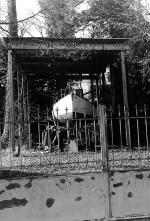|
Beck R J Frena N° 2 |
Manufactured or assembled in United Kingdom from 1899 to (After) 1900.
Index of rarity in France: Rare (among non-specialized garage sales)
Inventory number: 5794
See the complete technical specifications
Chronology of cameras Beck R J
The Frena models, manufactured by the London-based R & J Beck, emerged at the end of the 19th century.
Their operation is somewhat peculiar; the explanation was provided by F. Dillaye in La Gazette du photographe amateur in April 1894.
A few additional details are worth noting:
This model has a magazine for 20 sheet films, with an equal number of cardboard interleaf protective sheets, also notched, but differently from the films. As the explanation notes, to switch from one view to another, the front of the camera must be pointed upwards to unlock the rotation of the magazine (clockwise), a rotation performed using the side tube that incorporates a bubble level. This position must be maintained throughout the maneuver.
When the magazine has made a half-turn, the exposed film is released and falls to the bottom (at the back) of the housing. The operator continues to turn the magazine until it locks (almost a complete turn). It is then necessary to turn in the opposite direction; the intercalary cardboard is released in turn, above the film. One continues to turn in the opposite direction until the initial position is reached for the next photo.
The rounded cardboard edge at the back is used to keep the film-cardboard plate assembly in the rear, at the bottom of the camera, when it is held in its normal position, horizontally.
The adjustment of distances, for this Frena version, is done by rotating a disk, the edge of which can be seen to be manipulated at the front under the camera. Several lenses appear successively in front of the lens during the rotation of the disk. Each one adds to the fixed optics to achieve the desired correct sharpness; the adjustment distances are as follows: from Distance (infinity) to 27' (no additional lens in this position), from 27' to 9', from 9' to 6', from 6' to 4.5', and from 4.5' to 3.5'. An additional position completely closes the aperture; it does not seem superfluous, as light entries appear in the chamber due to a primitive rotary shutter.
By opening a flap at the front, still under the camera, you have access to the settings of the diaphragm disk (4 holes marked 8, 16, 32, and 256) and the shutter. For the latter, the front wheel under the lens is also necessary. The 4 speeds, visible in the lens, range from 1/5 to 1/40 of a second, with the T setting obtained by turning, then blocking, and finally releasing the disk of the flap with the finger (!).
The two viewfinders, remarkably clear, have a metal latch cover. This model has, on its front face, an original metal pattern not seen on any other camera of the brand. To identify it, in addition to the manufacturer's name, the word "Frena" is inscribed, but without a number.
The complexity of the mechanisms makes this camera difficult to use without a detailed user manual.


Under the lens, the speed adjustment button; under the camera body, the wheel for adjusting and indicating distances.
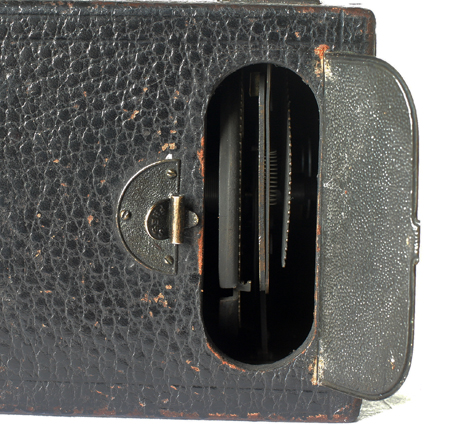
At the front, under the camera body, with the hatch open: on the right, a toothed wheel for adjusting the aperture; on the left, a wheel for adjusting and cocking the shutter.
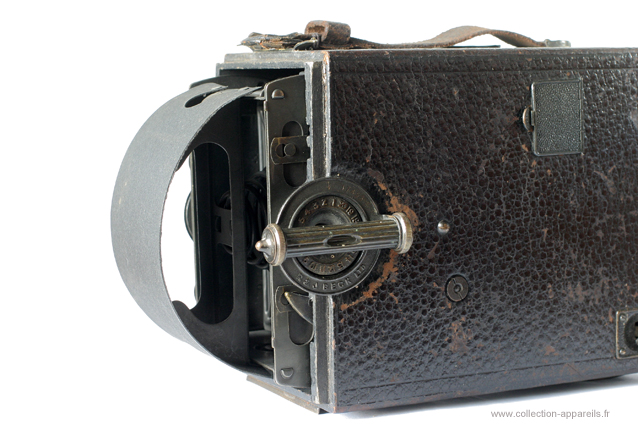
The magazine is in shooting position.

View of the magazine, film and interleaving paper side. On one edge, you can see the 6 film retention pins (there are as many on the opposite edge). Rotating the magazine moves these pins (here from top to bottom and vice versa), releasing the film or paper, with notched edges, at the bottom of the camera. The maneuver is done with the front (here on the right) of the camera facing upwards.
Guide for Beginners on Opportune Moments for Instant Photography. - A new magazine box camera with fifty films: the Frena-Camera. - Description of this camera. - Papers with varied tones.
All photography enthusiasts in general, and those fond of instant photography in particular, rejoiced at the sight of the marvelous sunny days that framed Holy Week and Easter vacations. If good light is one of the necessary conditions for obtaining good photographs, it becomes an absolute requirement when operating instantaneously, i.e., within time limits ranging from one-fifteenth to one-eightieth of a second, limits within which, with our current means, we can still obtain artistic prints. I would like to remind beginners, to serve as a guide, that the most favorable times of the day for indulging in the joys of instant photography are:
- January, February, November, December, from 11 am to evening.
- March, September, October, from 10 am to 2 pm.
- April, August, from 9 am to 4 pm.
- May, July, from 6 am to 6 pm.
- June, from 5 am to 7 pm.
I strongly advise beginners to adhere to these limits if they want to avoid too many setbacks. When they become accustomed to the very real challenges of developing instant photos and fully understand the correlation between the shutter speeds, lens brightness, and plate sensitivity, they can then judge how and by how much they can exceed these limits. I would like to point out that an absolutely blue sky does not provide the best lighting for instant photography, especially. In such cases, objects, excessively illuminated, tend to produce harsh phototypes,
 with disastrous opacity in the highlights and equally disastrous transparency in the shadows lacking in details or with very faint details that no longer appear in the print. A clear sky with beautiful white clouds that slightly veil the sun allows for more nuanced and detailed instant photos than a consistently blue sky. Additionally, as I have mentioned elsewhere, the atmospheric humidity has a significant impact. Operating after a light rainstorm yields excellent results.
with disastrous opacity in the highlights and equally disastrous transparency in the shadows lacking in details or with very faint details that no longer appear in the print. A clear sky with beautiful white clouds that slightly veil the sun allows for more nuanced and detailed instant photos than a consistently blue sky. Additionally, as I have mentioned elsewhere, the atmospheric humidity has a significant impact. Operating after a light rainstorm yields excellent results.It would be denying the obvious to refuse to acknowledge that enthusiasts are increasingly drawn to instant photography. Therefore, within the time limits I have indicated, with well-conducted development, one can, with a good device, obtain a print with transparencies sufficiently inversely proportional to the highlights of the corresponding parts of the object to provide a harmonious print. And, with enlargements, which lead us to artistic prints, I repeat, we can create art through small prints and consequently through hand-held devices. Initially, these devices had mobile frames, then detectives were made, containing a dozen plates. The enthusiasm for instant photography progressed rapidly, as all fads do, and the first ones were abandoned for the latter. However, twelve plates are few given the frequency of subjects provided by instant photography. They went up to eighteen, twenty plates... but, by increasing the number of plates, the weight of the device increased significantly. It was then considered to replace plates with films. This reduced the weight, or at an equal weight, one could have a larger number of shots. One of the best detectives constructed for this purpose is undoubtedly the one that comes to us from England under the name Frena-Camera. The most interesting one contains fifty films of the format of our projection plates and, when fully loaded, does not exceed a weight of 1.5 kg. I won't dwell on the bizarre combinations of syllables that determined the name of this new instrument. It's quite amusing but of no practical interest. Now, as this new device is eminently practical, I prefer to get straight to the heart of the matter.
Apart from the use of films, the Frena-Camera attracts our attention with its shutter mechanism and the very particular, as well as ingenious, retraction of the films.
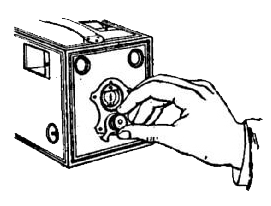 Positioned in front of a lens with a focal length of 115 mm, a first-class "Beck's rapid rectilinear" lens with a maximum useful aperture of F/11 and an absolute focus for any object located at a minimum distance of 4 meters, the shutter of the Frena-Camera can operate at speeds ranging from 1/6 to 1/80 of a second. These speeds are adjusted by enlarging or reducing an aperture that passes in front of the lens. A key point is that the translation speed of the shutter remains constantly the same, and there is no need to account for the tension of a spring, which inevitably remains uneven due to fatigue or changes in temperature. To arm this shutter, one grasps the button E between the thumb and index finger and turns it from left to right until a crisp sound indicates that the turn is complete and the shutter is armed. The lock lever F is fixed.
Positioned in front of a lens with a focal length of 115 mm, a first-class "Beck's rapid rectilinear" lens with a maximum useful aperture of F/11 and an absolute focus for any object located at a minimum distance of 4 meters, the shutter of the Frena-Camera can operate at speeds ranging from 1/6 to 1/80 of a second. These speeds are adjusted by enlarging or reducing an aperture that passes in front of the lens. A key point is that the translation speed of the shutter remains constantly the same, and there is no need to account for the tension of a spring, which inevitably remains uneven due to fatigue or changes in temperature. To arm this shutter, one grasps the button E between the thumb and index finger and turns it from left to right until a crisp sound indicates that the turn is complete and the shutter is armed. The lock lever F is fixed.Under the shutter, there is a small bossed aluminum plate B. If you move it right or left under finger pressure, the numbers 6, 12, 24, 48, 80 appear successively, corresponding to 1/6, 1/12, 1/24, 1/48, 1/80 of a second. This arming should never be done until after retracting the placed film. In the case of a posed shot, the shutter is set at 1/6 of a second, a peg placed above the button H is removed, which is then pressed to trigger, the necessary time is set, the lens is covered with the palm of the left hand, and with the right hand, the peg is replaced.
To load the Frena-Camera, it is placed on its base with the lens side, opened, and introduced into a box supporting the films in a packet. Each packet contains twenty films. The box is replaced, and it is pressed against the base by a spring-loaded board.
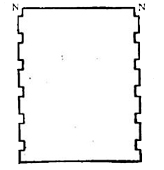 The films are separated by cards. Films and cards have notches on their long sides. Those on the cards are opposite to those on the films. This device is used for retraction. To do this, lift the Frena, lens upwards, release lever L from stop spring M, then pull the lever back to make it travel 5/6 of a circle. In this movement, it hits against the button of a spring, which is pushed inside while continuing the movement until it stops. This movement has displaced the points supporting the film inside. They have come to rest in the notches. The film, lacking support, has fallen. The pressure on the spring has put the points back in place. Consequently, they are now in the notches of the card, opposite to the notches of the film. The film is free and falls in turn. A new plate is in place for exposure. The lever is returned to its original position, and an indicator placed at P indicates the exposure made. In its normal position, the film holder forms a right angle with the lens axis and the lever when held by spring M. Thus, a slight movement of the lever forward or backward can bring the film into a tilted position forward or backward of the vertical plane. A valuable feature for churches, monuments, etc. I believe it is the only detective that has such a tilting movement.
The films are separated by cards. Films and cards have notches on their long sides. Those on the cards are opposite to those on the films. This device is used for retraction. To do this, lift the Frena, lens upwards, release lever L from stop spring M, then pull the lever back to make it travel 5/6 of a circle. In this movement, it hits against the button of a spring, which is pushed inside while continuing the movement until it stops. This movement has displaced the points supporting the film inside. They have come to rest in the notches. The film, lacking support, has fallen. The pressure on the spring has put the points back in place. Consequently, they are now in the notches of the card, opposite to the notches of the film. The film is free and falls in turn. A new plate is in place for exposure. The lever is returned to its original position, and an indicator placed at P indicates the exposure made. In its normal position, the film holder forms a right angle with the lens axis and the lever when held by spring M. Thus, a slight movement of the lever forward or backward can bring the film into a tilted position forward or backward of the vertical plane. A valuable feature for churches, monuments, etc. I believe it is the only detective that has such a tilting movement.The films used in the Frena-Camera are highly sensitive. Therefore, they should only be handled in very good red light. Before developing them, it is good to soak them for a few moments in a water basin to ensure their flatness. Moreover, their treatment, being that of films in general, has nothing special, and I have no intention of elaborating today on the qualities or defects of this new process, which is highly favored in America and England but less used in France.
I have just told you that by acting on lever L, you automatically press a spring button that is pushed inside. This maneuver not only aims to move the points supporting the film and bring them into the notches but also allows the action of atmospheric pressure, without which the film could not fall due to its low weight

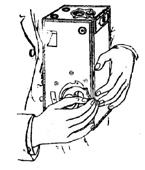 . The diaphragms, indicated by the letter C on the front view, have apertures of F/8, F/11, F/16, F/22, F/64. As I started by providing opportune movements for instant photography for beginners, I will remind them about the Frena-Camera's key exposure duration using the medium diaphragm and operating outdoors:
. The diaphragms, indicated by the letter C on the front view, have apertures of F/8, F/11, F/16, F/22, F/64. As I started by providing opportune movements for instant photography for beginners, I will remind them about the Frena-Camera's key exposure duration using the medium diaphragm and operating outdoors:In May, June, and July: Marine views, 1/80 second; busy and well-lit streets, 1/48 to 1/24; landscapes without dark foregrounds, 1/24; landscapes with foliage in the foreground, 1/12 to 1/6; full-body portraits in the shade, 1/6; bust portraits, 2 to 3 seconds.
In March, April, August, September, increase these numbers by half.
In February and October, double them.
Quadruple them for other months.
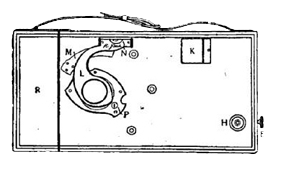 As it is, with dimensions not exceeding 20 x 15 x 10, a reduced weight of 1,500 grams, the number of provisions it contains, its excellent lens, its viewfinders providing a very clear and upright image, its very particular shutter mechanism, its retraction system, and the resources of its tilting frame, the Frena-Camera constitutes a precise and choice detective, a valuable tool for photographers, a marked improvement over its counterparts. It only lacks the eye-level viewfinder, which is one of the fortunate principles of the Carpentier photo-twin lens among the numerous fortunate principles that this remarkable detective contains.
As it is, with dimensions not exceeding 20 x 15 x 10, a reduced weight of 1,500 grams, the number of provisions it contains, its excellent lens, its viewfinders providing a very clear and upright image, its very particular shutter mechanism, its retraction system, and the resources of its tilting frame, the Frena-Camera constitutes a precise and choice detective, a valuable tool for photographers, a marked improvement over its counterparts. It only lacks the eye-level viewfinder, which is one of the fortunate principles of the Carpentier photo-twin lens among the numerous fortunate principles that this remarkable detective contains.As I promised to occasionally revisit various means of obtaining phototypes and photocopies outside of common processes, I will conclude by highlighting a presentation made by Mr. Rouillé Ladevèze at the Photo-Club of Paris in its session on March 7th last. It concerns the update of a fairly curious paper printing process.
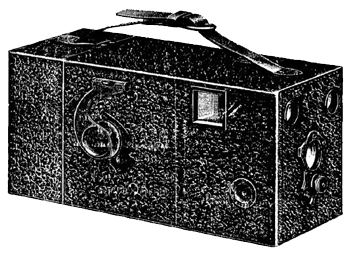 A paper with varied tones obtained through watercolor colors. In a few words, here is what it consists of: dissolve a color cake in water to form a semi-fluid paste, and mix two parts of a fairly thick gum solution and two parts of a saturated solution of potassium bichromate or ammonia (7.4% of the former and 9 of the latter) into this mass. Knead it all in a mortar to give the paste as much homogeneity as possible, and using a brush, spread this mixture on the white paper sheet you have chosen. Smooth paper, coarse-grained paper, watercolor paper, etc. Let it dry in the dark. Insolation with a contact-printing frame takes ten to twenty minutes in the sun or one to two hours in the shade. To develop, wash it thoroughly with warm water or under a fountain tap. Since the bichromate has made the parts touched by light insoluble, the paper sheds all the coloring matter spread on the other parts, and the image appears on the white background in the color you used: carmine, red, green, yellow, bistre, etc. In this very simple method, which is ultimately a corollary of the charcoal method, there is an inexhaustible mine for a photographer with developed artistic sense, providing a way to obtain original photocopies with a charm that no other method of obtaining can present.
A paper with varied tones obtained through watercolor colors. In a few words, here is what it consists of: dissolve a color cake in water to form a semi-fluid paste, and mix two parts of a fairly thick gum solution and two parts of a saturated solution of potassium bichromate or ammonia (7.4% of the former and 9 of the latter) into this mass. Knead it all in a mortar to give the paste as much homogeneity as possible, and using a brush, spread this mixture on the white paper sheet you have chosen. Smooth paper, coarse-grained paper, watercolor paper, etc. Let it dry in the dark. Insolation with a contact-printing frame takes ten to twenty minutes in the sun or one to two hours in the shade. To develop, wash it thoroughly with warm water or under a fountain tap. Since the bichromate has made the parts touched by light insoluble, the paper sheds all the coloring matter spread on the other parts, and the image appears on the white background in the color you used: carmine, red, green, yellow, bistre, etc. In this very simple method, which is ultimately a corollary of the charcoal method, there is an inexhaustible mine for a photographer with developed artistic sense, providing a way to obtain original photocopies with a charm that no other method of obtaining can present.FRÉDÉRIC DILLAYE.
La Théorie, la Pratique et l'Art en photographie.
p. 312, in " La Science Illustrée".
__________
In 1854, two brothers, Richard and Joseph Beck, renamed their London-based optics and microscope company to R & J Beck Ltd after the withdrawal of their third partner, James Smith. The production of cameras began in 1880, and it was in 1892 that the Frena models with their unique system of a notched-edge roll film magazine were introduced.
Interesting links or bibliography :
Add a link or element of bibliography, a picture taken with this camera, a picture of box or an ads about this camera
Your photos taken with the same camera:
Cameras from Ebay France (Beck R J) (Uploaded each 3 hours)






